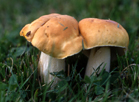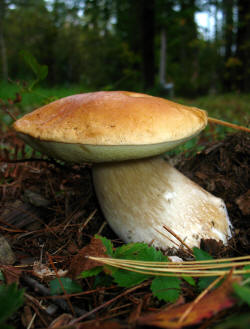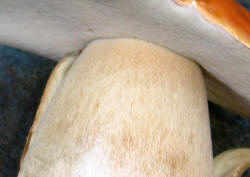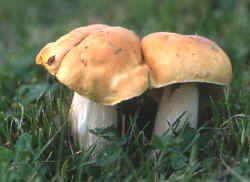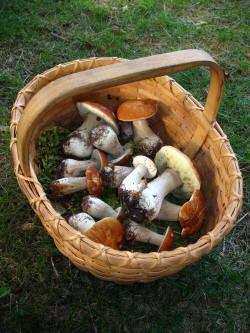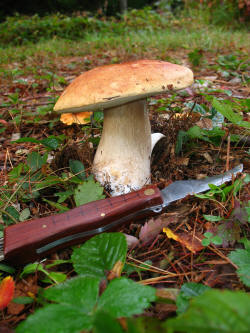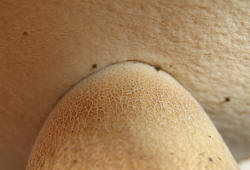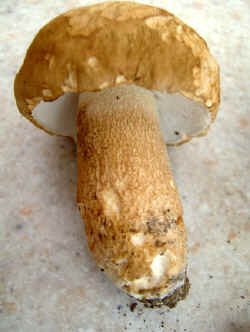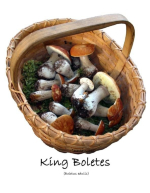|
|
A New England and Eastern Canada Edible and Medicinal Mushroom Resource |
||||||||||||
|
King Bolete
The King Bolete is a very popular, delicious, meaty mushroom that grows all over the world. It has many names such as king, cep, porcini, steinpilz, penny bun and many others. It is apparently a complex of closely related species with similar looks, habitat, and flavor wherever it is found. It is highly variable in coloration. More study of this group will be required to sort out the variants more accurately. The king is a favorite and familiar mushroom drawn, painted or sculpted by artists. The king is often very large and stately with a thick club shaped stem, thick cap and an impressive kingly appearance. Cap (pileus) 2-10 inches broad or larger, smooth, and quite thick and a bit sticky in damp weather. Convex becoming flat at maturity. The color is quite variable from light brown to reddish brown. It is dense when young becoming a spongy with age. The aroma is pleasant. Pores (hymenophore) Closely spaced small pores are white. The pore layer is quite hard when young and white changing to yellowish then to pea soup green to greenish brown becoming fairly soft at maturity. Stem (stipe) Very thick and club shaped. When young it is often almost as thick at the bottom as the cap is wide. The stem is usually finely reticulated meaning it has a net shaped raised pattern on the surface. The reticulation is most pronounced near the top. The color can vary from whitish cream to reddish brown. It can become cylindrical at maturity. Flesh The flesh is white and dense in younger specimens becoming softer at maturity. It is generally non-staining and has a pleasant flavor when raw. Spores Olive brown When and where to find them (ecology) King boletes are mycorrhizal and are most commonly found under hemlock and oak especially where sphagnum mosses are present. They are also fairly common under most varieties of spruce. Lawns and grass under conifers are another common habitat. Technically, true Boletus edulis will be found under conifers like hemlock and spruce but there are many unexplainable finds. I have also found "variants" with birch, beech, apple, mixed woods and eastern white pine (Boletus pinophilus). I should note that the fruit bodies I have collected under white pines were very similar to B. edulis and fruited in the fall. They did not closely match the B. pinophilus on some other websites. In Maine they will be found from the end of August through the middle November. Some field guides will say they are uncommon in the east which is not remotely true in my experience. They grow in my front yard. Although the last three years have been quite poor, usually they are quite abundant. In 2002 I was attending college and found almost enough to pay my tuition for the two courses I was taking. I found one location where I collected 90 pounds and another with over 40 pounds. I had so many that year that I had to sell most of them. In June and July you may find the very similar looking Boletus variipes under Oak. It has a tan, dry cap and usually a more strongly reticulated more cylindrical stem. Its flavor is not as good as the king bolete and most specimens I found had a slight bitter edge. It is available at a time when there is not much else to find. Xanthoconium separans (yellow pores) and X. affine have a similar look and are also good to eat. The past 3 years, (05, 06, 07) the weather has been unusual and B. edulis has been scarce. Climate change may have far reaching effects on local fungal populations. Someone recently suggested to me that climate change was a good thing. I think one should be very careful what they wish for. Preparation King boletes are excellent sautéed, fried or even microwaved. The flesh is crunchy with a somewhat nutty flavor. They occasionally have a slight bitter edge. For the pan you may wish to remove the pore layer on older specimens but for drying it is fine to leave them on. Boletus edulis is truly great dried and reconstituted. Drying concentrates the flavor and ameliorates any slight bitterness. When powdered, they impart strong flavor that is great for soup, gravy, meat loaf, pasta sauce etc. Don't use too much. I learned the hard way by putting a layer on some chicken and baking it. Dang! Way too strong! Comments Early finds of Boletus edulis will often be quite buggy. Check the bottom of the stem for holes made by the maggots of fungus gnats. Once cold weather sets in this becomes less of a problem. Often they come up most strongly around the time of frost. Frost or near frost conditions reduce infestation problems greatly. Sometimes kings can be gargantuan. In 1999 I found one with a 14 inch cap that was over 4 inches thick. The stem was close to 4 inches thick as well . It weighed over two pounds. In Summer and early Fall you may find Tylopilus felleus, the bitter bolete. It is usually tan or reddish tan with a similar colored stem and fairly prominent reticulation. The pores often have a pinkish tinge. It is very similar to B. edulis in appearance but has a truly unpalatable level of bitterness. Early in the season it is best to taste a very small bit of flesh from your finds. You will spit out T. felleus immediately. I have been fooled. Yuck. Kings can be used for dyeing textiles or paper and will yield a chrome yellow color when ammonia is used as a mordant.
Find more information here: Boletus
edulis at MushroomExpert.com
If you like my photography, I have products like tee
shirts, aprons, coffee cups, and other items
available here.
Use of this site will constitute your acceptance of the disclaimer. Copyright 2011 Mushroom-Collecting.com. All rights reserved. |
||||||||||||
